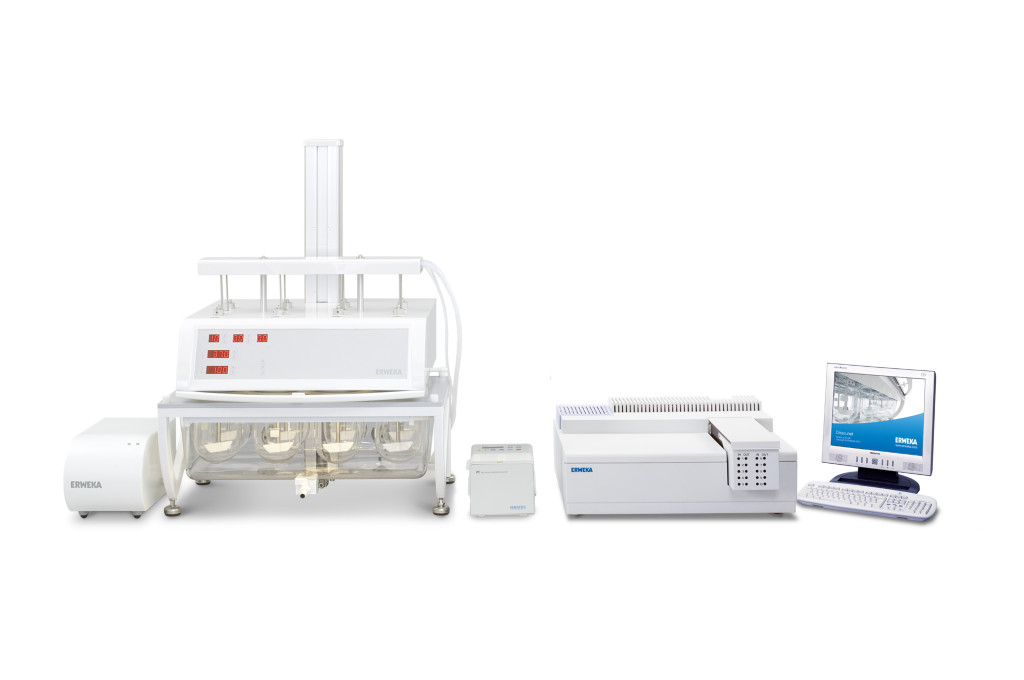There’s a lot of options to consider when using or purchasing dissolution equipment, and more often than not, dissolution systems have many possible configurations. To make things a little easier, the TLS team have compiled this useful reference detailing the various terms and apparatus used when dealing with dissolution equipment.
The core pieces of dissolution equipment:
These are the various pieces of dissolution equipment that encompass the basic dissolution machine.
Water Bath
The container that holds the heated water, located at the base of all dissolution testers.
Test Stations
The number of places able to hold vessels, thus dictating the number of tablets that can be tested per session.
Vessels
The glass containers which hold the test media and tablets.
Media
The specially prepared liquid that is held in the vessel. Often mimicking the human stomach.
Drive Head
The electronic, motorised unit that controls the dissolution tester and drives the paddles and shafts.
Height Operation
The distance of the drive unit from the vessel. Some dissolution equipment offers both high and low capabilities. This often requires different lengths of shafts.
Paddles and Shafts
The often metallic movers and stirrers that create movement in the dissolution vessel. There are different types of paddle and shafts depending on the type of dissolution test being performed.
USP 1 is a basket on the end of a shaft.
USP 2 is a paddle on the end of a shaft.
USP 3 is a reciprocating cylinder on the end of a shaft.
USP 5 is a paddle over disk environment (a mesh disk is placed beneath the paddle).
USP 6 is a rotating cylinder on the end of a shaft.
USP 7 is a reciprocating holder on the end of a shaft.
Sinkers
These are small containers used to keep floating tablets submerged inside a vessel. There are several types available.
Heaters
The small, often exterior unit that heats the water bath, creating and maintaining a constant testing temperature.
Dissolution equipment systems:
Extra pieces of dissolution equipment are incorporated to form ‘systems’, often described as follows.
Offline System
A system whereby test samples are removed from the vessel and stored for analysis at a later date, at a location separate from the dissolution system environment.
Online System
A system whereby test samples are removed from the vessel and analysis within the dissolution testing system, often during the test itself.
Online/ Offline System
A dissolution system whereby both local analysis is performed as well as extracted sample collection, often performed within the same single test.
Semi-Automated
A process whereby the human involvement in the test is reduced, often exemplified with the use of automatic sampling and pumping equipment to extract and transport the test media to and from the vessels and analytic machinery.
Automated
A very specialised piece of dissolution equipment, whereby almost everything is performed automatically without human interaction required. Common aspects of the dissolution test are performed mechanically, such as cleaning, media preparation, tablet dropping, sampling, collecting and analysis.
Sampling Methods
The process of removing samples of vessel liquid for dissolution analysis. You can utilise manual samplers – often a syringe – to extract the sample yourself, or have a pump do it automatically.
The individual pieces of a dissolution equipment system are commonly made up of the following items.
Peristaltic pump
A mechanical pump that automatically extracts and transports sample liquid from the vessel to fraction collectors, spectrophotometers and other containers and analysers. Pumps can also return sample liquid back to the vessel as well.
Fraction Collector
A machine that collects samples and stores them in test tubes for later analysis. Often employed within an Offline dissolution system.
HPLC Unit
Stands for High Performance Liquid Chromatography. In terms of dissolution, a HPLC machine can separate components of a liquid and both identify and quantify them respectively.
UV/Vis Spectrophotometer
Stands for Ultraviolet Visible Spectroscopy or Ultraviolet Visible Spectrophotometry.
A machine that measures the concentration of light passing through a test sample and compares it to the amount of light before it passes through the sample. This allows for the analysis of the different compounds of the test sample. This is often employed within an Online dissolution system.
Media Preparation Unit
The term used to describe the preparation of the test media (liquid) to be used inside the vessel. Often media preparation machines are used to degas, mix and heat the test media prior to the test commencing.
Other Dissolution equipment systems:
Sometimes more specialised dissolution equipment is required for a more individual type of testing.
Flow-Through System
A type of dissolution system whereby the test media is circulated through the vessels, creating a constant flow of the liquid. This can be used within a closed loop system or open. Closed is the recirculation of the same media, and open is where the old media is constantly being replaced with clean/new. Also commonly referred to as USP 4.
Multiple Media Change System
A term used to describe a dissolution system where the test media is swapped repeatedly. For example, you might require different strengths of acidic test media to be used within in a single test, so a multiple media change system would be required to facilitate this. Often referred to as USP 3 and/or 7.
Dissolution equipment is designed and built to ridged specifications, laid out by industry bodies such as the United States Pharmacopeia (USP) and European Pharmacopeia (EP). These institutions recommend set standards to ensure that the manufacturing, testing and selling of pharmaceuticals is of a guaranteed quality and standard, irrespective of where the drug is produced. These guidelines apply to every piece of dissolution equipment in use, and each aspect is routinely monitored by specialist technicians to ensure the standards and specifications are maintained.
You can view our entire range of dissolution testers and associated systems here.

